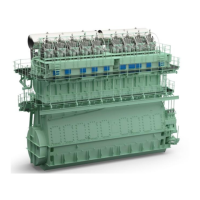Operation0710−1/A1
Winterthur Gas & Diesel Ltd.
10/ 12
Distillate fuels are used more in 2-stroke engines to meet area specified emission
standards. They are easier to operate than residual fuel, but caution is necessary for
some problems. See Service Bulletin RT−82: Distillate Fuel Use.
ISO 8217: 2010 specifies DMX, DMA, DMZ and DMB categories. The WinGD engine
inlet specification is based on the DMB grade which is the highest viscosity grade.
The DMX grade must not be bunkered as the viscosity could be below 2.0 mm
2
/s and
the flash point could be below 60_C.
5. Data about Distillate Fuel Specifications
5.1 Viscosity
The recommended viscosity range on residual fuel upstream of the engine inlet is
13 mm
2
/
s
(cSt) to 17 mm
2
/
s
(cSt). But, because distillate fuel does not have such a
high viscosity, a minimum viscosity of 2.0 mm
2
/
s
(cSt) at the fuel pump inlet is
necessary.
Operators must be careful during the change-over procedure from distillate to residual
fuel and back to make sure of problem free operation. See the Service document:
Engine operation on MDO/MGO, change-over from HFO to MDO/MGO and the
Service Bulletin RT−82: Distillate Fuel Use.
In some conditions, it is possible that you cannot get the minimum viscosity of
2.0 mm
2
/
s
(cSt) at the fuel pump inlet. In such conditions, a fuel cooling system will be
necessary to make sure that the inlet to the fuel pumps has the minimum viscosity.
5.2 Density
The composition of the fuel gives the distillate density and a high density indicates a
high aromatic quantity.
5.3 Cetane Index
The ignition and combustion properties of a distillate fuel in a diesel engine is related
to the specific engine design, load profile and fuel properties. The Cetane Index is a
calculated quantity of the ignition properties or ignition interval of the fuel related to
the distillation and density. The density and the temperature when 10%, 50% and
90% of the fuel is distilled, gives the Cetane Index. This has no effect on the fuel
combustion properties.
5.4 Sulphur
Sulphur limits are specified in ISO 8217:2010 for distillate fuels, but statutory
specifications must be obeyed. The alkalinity (BN) of the cylinder lubricating oil must
be selected in relation to the sulphur content of the fuel in use.
The engine can operate for short periods (some hours) with a cylinder lubricating oil
that has an incorrect BN, but a longer operation time must be prevented.
Indications for the selection of the BN of lubricating oil in relation to the sulphur
content of the fuel are found in:
D 0410−1 Running-in New Cylinder Liners and Piston Rings
D 0750−1 Lubricating Oils, paragraph 3.
5.5 Flash Point
The flash point is an important safety and fire hazard parameter for diesel fuels. Fuel
is always a fire hazard because there can be flammable vapors above the remaining
fuel in the tanks.
2017−08
Diesel Engine Fuels

